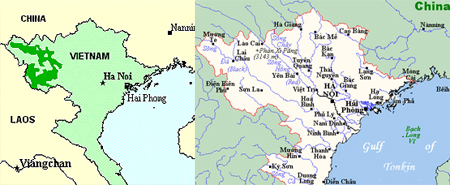Gina Hellweger collected this silver hair pin topped with a French coin from 1936. Kajetan Fiedorowicz identified it. It was made by the Black Tai Dam.

In 1250 BC, the Mongols destroyed the Tai kingdom of Nan Chao, and all the ethnic groups who made up the Tai people left China. Each group had distinct languages and customs.
The Black Tai followed a tributary of the Red River, called the Black River, and settled in highland valleys of northwestern Vietnam and northeastern Laos. Religion centered around the worship of spirits and ancestors, and they believed in a multiple personal soul. Black Tai’s had darker skin, wore black, and were quite different from the White and Red Tai’s. As a woman born in 1939 wrote, “Bravery, discipline, stoicism, physical toughness, and loyalty are the ethical values of our mountain warriors.”

The White Tai settled in South Vietnam. In 1889, a White Tai leader formed an alliance with Chinese opium traders and defeated the Siamese, who had conquered Vietnam in 1782. Siam tried to stop this with the help of the Black Tai, but failed. Four years later, the French took over.
From 1940 – 1954, the French forced Black Tai farmers to increase their opium production, while their allies, White Tai feudal leaders, underpaid them because farmers had no other market for their crops.
In 1941, Ho Chi Minh left Europe after having embraced Communist ideology. He married a Black Tai woman, established a Communist government in 1945, incorporated the Black Tai into the Viet Minh army, and defeated the French at the famous battle of Dien Ben Phu in 1954.
Northwestern Vietnam after Dien Ben Fu, 1954
Black Tai village 2 kilometers away from Laos today
Black Tai woman in the rice fields

i am from the north east part of india, and my community is called “meitei”, some say that we are a broken group of the black tais, the burmese people refer to us ka-te, derived from the word ka-tai, which means a broken family of tai. do you think there might be some ancient relations?
I will ask. Thank you so much for writing in.
I’d just like to observe, as a matter of interest, that we own a very similar hairpin, shown on p. 231 of Truus Daalder, *Ethnic Jewellery and Adornment*. In our experience these pins are not particularly frequent. Our example is very similar in basic shape to Gina’s: it has a lengthy cone for its basic formation (that of the hairpin), and the top consists of a coin. The coin is in our case from Yunnan. The piece was collected in Laos by someone who actually lived there, and it appears to have been worn by the Lisu. Attached to the object is a chain with dangles (probably just for decoration?). There was of course a lot of interaction between South West China and its minority groups on the one hand and Laos and the Golden Triangle in general on the other. The coin is definitely from Yunnan (home of several Chinese minorities), and the dangles also have a rather Chinese look. The cone, however, is of the kind of silver more often found in Laos, where the piece may well have been made, even if incorporating material from China.
Thank you very much for your comment. I will pass this along to Gina.